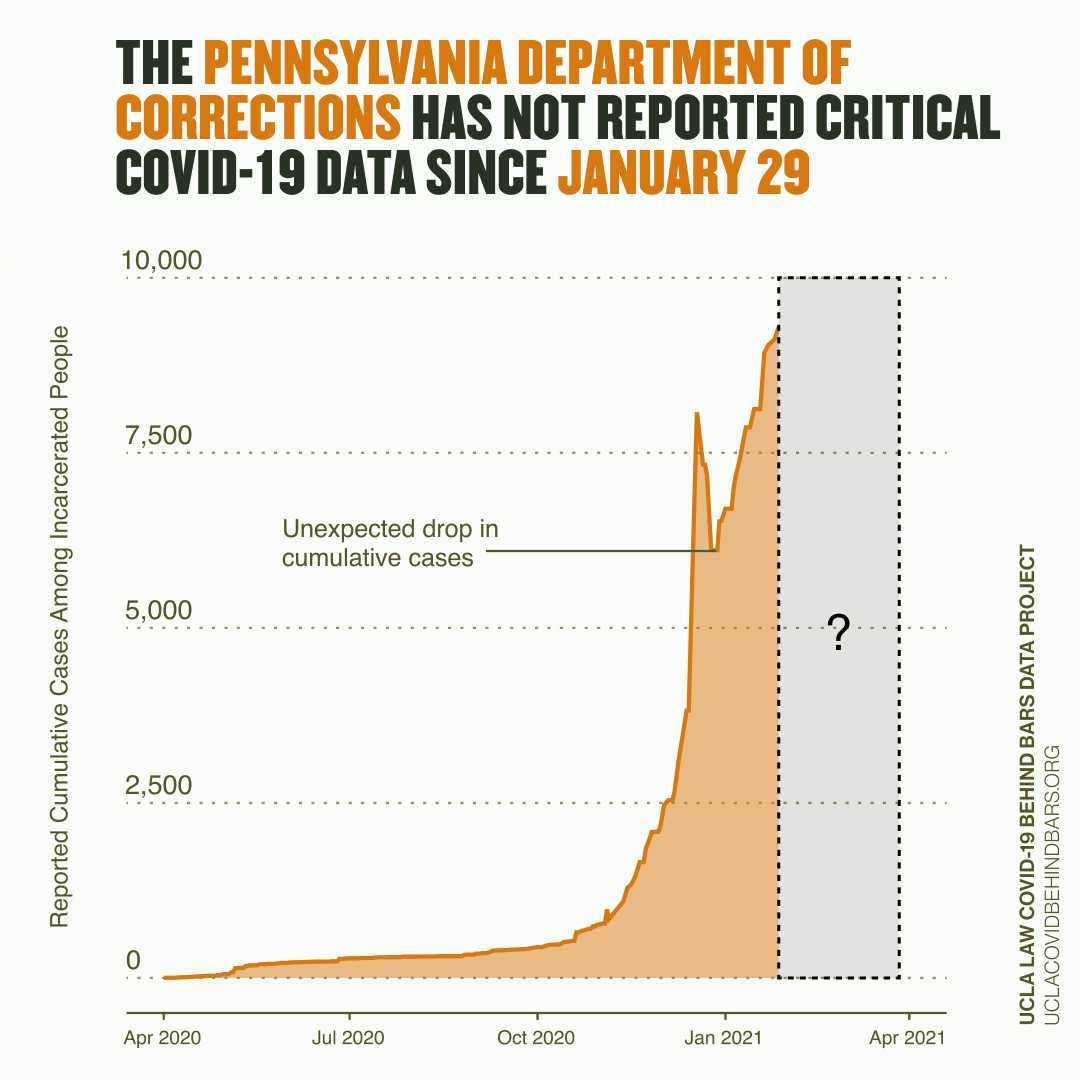March 30th, 2021 • Erika Tyagi, Liz DeWolf, and Joshua Manson
Two Months (And Counting) Without Critical COVID-19 Data from Pennsylvania Prisons
Toward the end of last year, the COVID-19 data reported by the Pennsylvania Department of Corrections was fraught with errors, including troubling inconsistencies and fluctuations in the numbers of cumulative COVID-19 cases, tests, and deaths. Over the course of a week, we saw the number of cumulative cases reported by the agency — the total count since the start of the pandemic — fall from over eight thousand to just about six thousand, with no explanation provided. There were also similar issues with the agency’s data on cumulative tests and even the number of individuals who had died from COVID-19 in the state’s prisons.
After a public outcry, on January 29, the department acknowledged that the issues were “unacceptable” and took down its COVID-19 tracking dashboard entirely, outlining plans to keep it offline for 30 days to update its data reporting systems.
More than two months later, Pennsylvania officials have yet to reinstate the dashboard. And although the agency has been posting PDF reports with facility-level data for some of the variables the dashboard previously featured, two of the most important data points are still missing for the more than 37,000 people in its custody: cumulative cases and overall tests.

These variables are far more important than they may seem. Without data on cumulative infections, it’s impossible to know how many people have been infected over the course of the pandemic and exactly how widespread an ongoing outbreak is. Without knowing the number of tests administered, we have no way of calculating a positivity rate, nor of knowing whether the reported number of active infections reflects actual COVID-19 prevalence or is instead artificially low as a result of insufficient testing — a low number of active infections could be the tip of an iceberg hidden by poor testing.
As we’ve previously outlined, access to these data is critical for policymakers and public health officials responding to outbreaks. It is also important for families and friends of incarcerated people, who are often the primary advocates for the health and safety of their loved ones. When the PA DOC announced that it would be taking its dashboard offline, Secretary John Wetzel said it was “ [his] priority to ensure that the families, advocates, and partners who are cut-off from those in [PA DOC] custody receive the accurate and timely data that they need — both to continue their missions and to quell their understandable fears.” Unfortunately, these stakeholders largely remain in the dark.
The PA DOC, like many other state correctional agencies, is behind in reporting data on vaccinations. Last week, Spotlight PA reported that three of the state’s prisons have begun offering vaccines to incarcerated people and staff, and that upwards of 70 percent of people at two of those facilities have been vaccinated. The PA DOC has indicated that its new dashboard will include data related to the vaccine rollout, but this, too, is subject to indefinite delay.
The PA DOC is by no means the only carceral agency with poor reporting practices — throughout the pandemic, our data collection efforts have been hampered by abhorrent data transparency and reporting from jurisdictions across the country. But its delayed dashboard rollout illustrates the critical need to hold officials accountable for reporting timely, accurate, and accessible data — for exactly the reasons Secretary Wetzel identified.
next post
April 2nd, 2021 • Joshua Manson and Liz DeWolf
The Federal Bureau of Prisons Is Even Less Transparent Than We’d Thought
In recent weeks, the BOP has reported a decrease in total COVID-19 cases — an illogical trend for a number that presumably can only increase over time. An agency spokesperson informed us that the drop in reported cases was not, in fact, an error. Rather, it was the outcome of an intentional reporting choice.